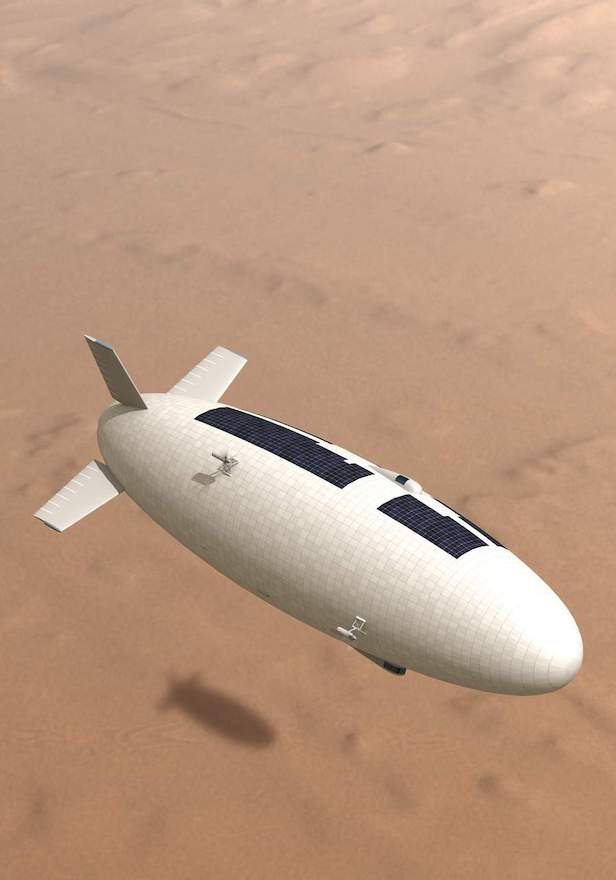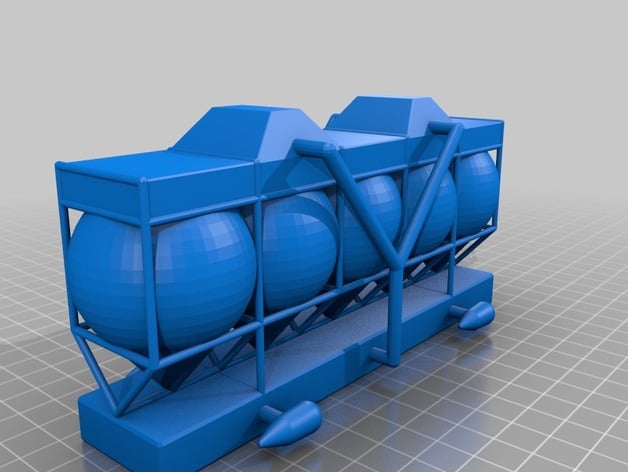New Mars Forums
You are not logged in.
- Topics: Active | Unanswered
Announcement
#26 2024-05-21 03:24:29
- PhotonBytes
- Member
- From: AUSTRALIA
- Registered: 2019-12-28
- Posts: 116
- Website
Re: Mega Igloo ice cavity in Korolev Crater
Since we have high air balloons on Earth then the ability of Mars lift effectiveness of balloon is more than 100 times less on mars.
https://www.researchgate.net/profile/Do … n-Mars.png
A mars balloon might appear like this
https://www.gaerospace.com/wp-content/u … loons2.jpg
First of all I want to thank everyone especially Calliban for getting me a head start on the design process and getting me educated on the structural aspects of a balloon which is valid.
But even after all the structural considerations please realize that Mars as less gravity as a smaller planet that actually in signficant ways compensates almost completely perhaps exceeds the advantage of balloons on Earth too.
Your most recent chart only goes up to 25 meters and shows a illustration of such a balloon size.
However if you will refer right back to the chart I sent you before you will see that with the reduce Martian gravity when you go above 160m radius you get back some significant gains. I would encourage you to extend your chart all the way to 200 meters radius and rerender your AI inspired illustration to show what the new balloon would look like at that scale. The only disadvantage with Mars is the minimum radius. Once you go pass 160m radius you can catch up to Earth abilities. Lift force too strong for balloon structural integrity? No problem, what you then do is set limits for the descend and ascent (climb rate) rate. Have a no exceed limit for climb. Then the extra mass needed for internal skeleton is much reduced and you still have your exponential gain.
Remember a larger balloons means higher altitude of lift and higher force of lift but we can control the lift force but controlling how much hydrogen is in the bags. We can carefully keep the amount of gas controlled so the balloon radius is in practice less than what it physically is.
M A R S H A S L E S S G R A V I T Y = Scale Height is elongated meaning also the max altitude is much higher than that on Earth because the air density changes are likewise stretched farther out into space. Because Mar's scale height is 11km vs Earth's 8km Mars atmospheric layer is actually thicker but the air density is not. Mar's atmosphere reaches farther out into space, this is true, while Earth's atmosphere is "thinner" it's denser. This is a tricky play on symatics that you might not be normally familiar with for Mars because the of media portrayal.
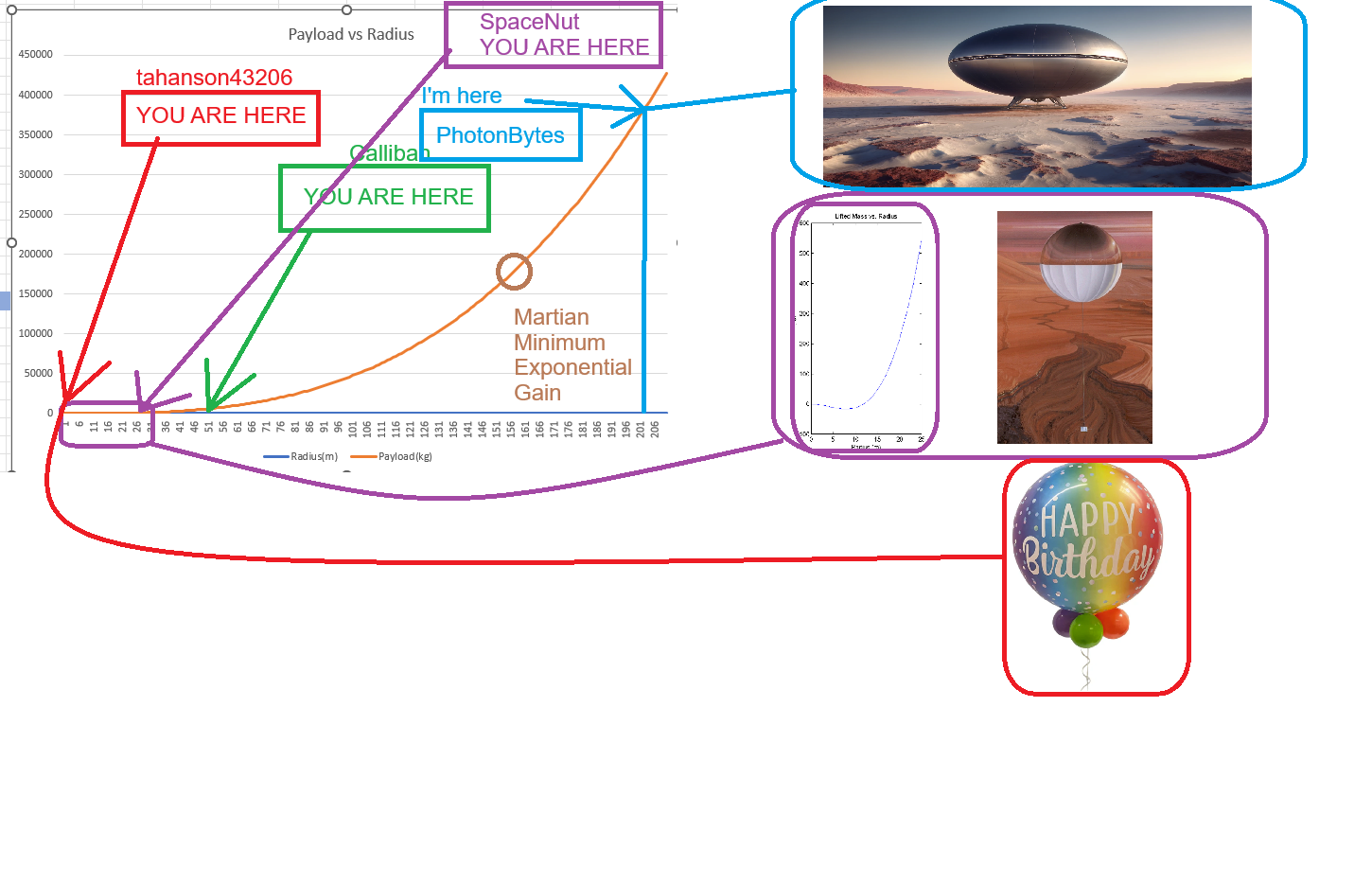
Below: Factoring in balloon mass which looks like it has a linear relationship after a certain point on the cart still gives no significant problems when you go to 200m, here after subtracting balloon mass you still have 385 tons of useful payload. I would design the balloon so that both structure and cabin spaces are integrated into the balloon material for further optimizations and to strengthen the skin, more of this integration into the balloon skin would be at the bottom to keep the ship/balloon (their both the same in this scenario - look at my picture) upright. Keep more mass on the bottom.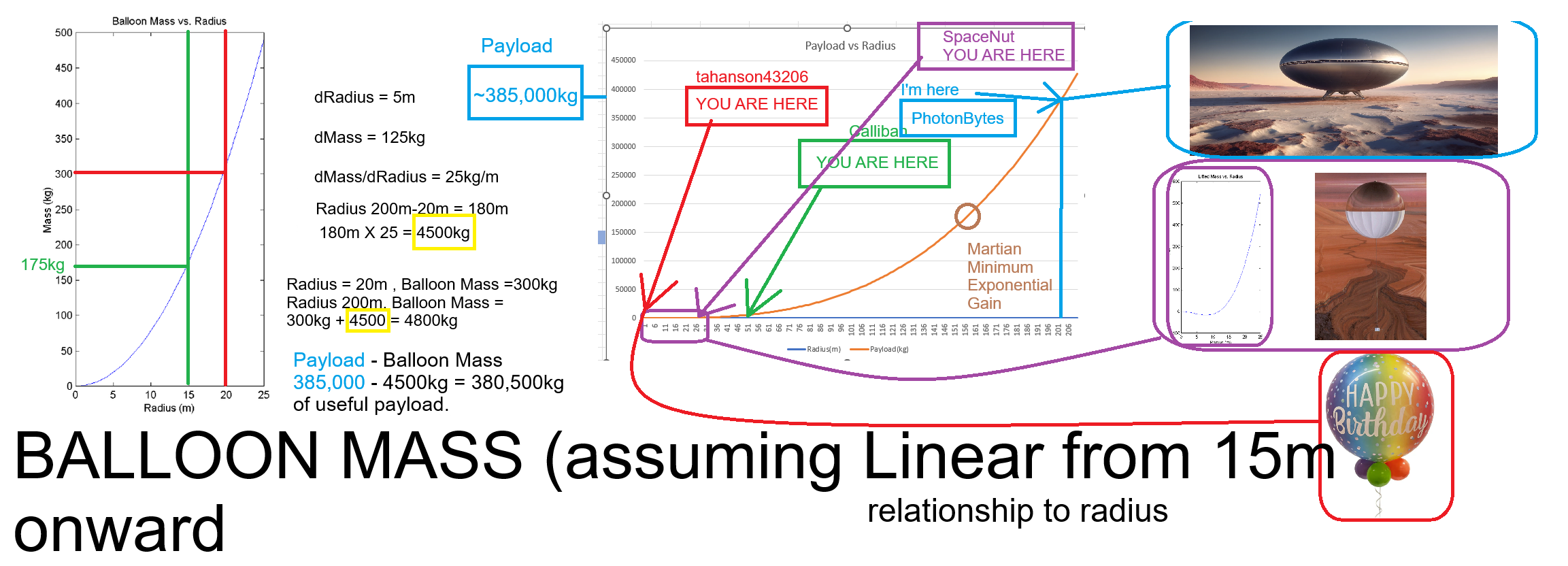
Pros and Cons of Martian Airships:
Cons:
1. Rise and Fall of airship is going to be limited due to weak Martian Gravity which actually cancels out the problem of structural integrity brought up by Calliban. However because of limited climb speed control of the airship wont be as great vertically compared to Earth airships which can climb and fall much quicker. However we can compensate with propulsion systems such as high RPM rotors or better still ion wind systems - ionowind propulsion. This works better on Mars due to laminar nature of atmosphere.
2. Ship has to be at least 160m in radius.
Pros:
1. Mars has low gravity cancelling out the low density atmosphere problem to a significant extent.
2. Mars has large scale height of 11km vs 8km of Earth. Enabling higher possible altitudes since the drop in air density is not as fast as that on Earth as you rise.
3. Because of low Martian Gravity Structual integrity issue brought up by Calliban is less of an issue. The balloon climb rate is going to be weaker and the disadvantages outlined in part 1 of cons.
UPDATE: Also NASA is doing this, here is an updated graphics that will cheer up Calliban as now he is included in it with association with NASA
https://www.everand.com/article/5624454 … n-Airships
https://www.spaceanswers.com/futuretech … pacecraft/
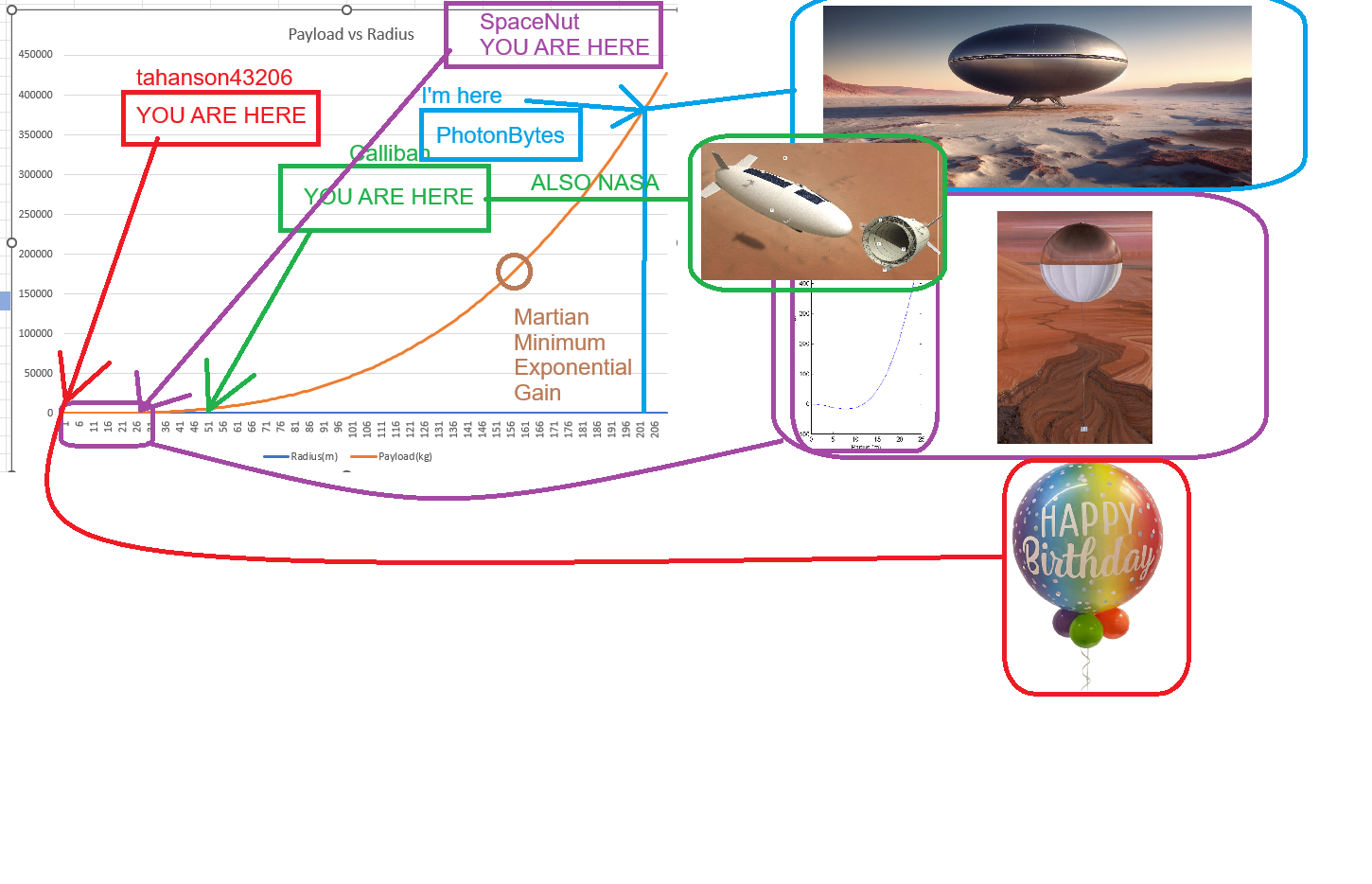
Last edited by PhotonBytes (2024-05-21 10:29:01)
I play the piano
https://fb.watch/s7XPqxw02-/
Offline
Like button can go here
#27 2024-05-21 18:10:30
- SpaceNut
- Administrator
- From: New Hampshire
- Registered: 2004-07-22
- Posts: 29,846
Re: Mega Igloo ice cavity in Korolev Crater
Thanks, PhotonBytes for the participants charts but I have other resources to bring to the plate.
One must remember that the ballon is coming from Earth so it's going to be deflated and brought to the surface to bring into being.
something like this ve3nus transport.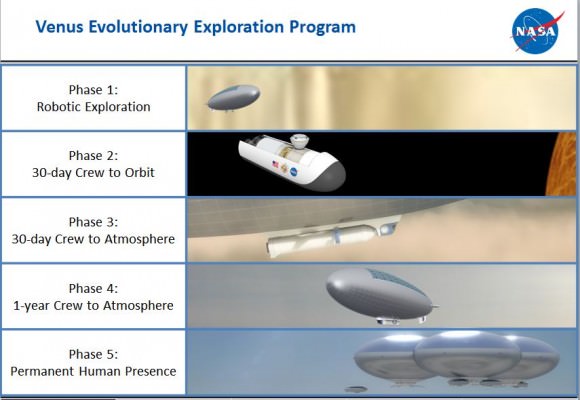
No need to be higher than what a parachute can inflate at for the EDL approach for how high the balloon needs to be at for most of the planet. Dust storms will also mean that there is a need for a covering that can take the sand blasting that it will receive.
Of course, on earth we heat the air to provide lift and vent it as well as drop sandbags to bring it stability. One might be able to use bags of dry ice and heat to add or vent it much in the same manner.
Hot Air Lifting Force
The lifting force from a hot air balloon depends on the density difference between balloon air and surrounding air, and the balloon volume. The lifting force can be calculated as
https://www.engineeringtoolbox.com/hot- … d_562.html
Fl = V (ρc - ρh) ag
where
Fl = lifting force (N, lbf)
V = balloon volume (m3, ft3)
ρc = density cold surrounding air (kg/m3, slugs/ft3)
ρh = density hot balloon air (kg/m3, slugs/ft3)
ag = acceleration of gravity (9.81 m/s2, 32.174 ft/s2)
another balloon type Vacuum balloons
https://en.wikipedia.org/wiki/Superpressure_balloon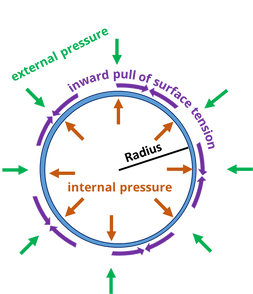

Offline
Like button can go here
#28 2024-05-23 02:06:54
- PhotonBytes
- Member
- From: AUSTRALIA
- Registered: 2019-12-28
- Posts: 116
- Website
Re: Mega Igloo ice cavity in Korolev Crater
Out of curiosity, how does NASA plan to get the people off the balloons in Venus back to Earth?
I'm currently doing research on the balloon skin mass for Mars, will be busy for the next few days until I have an answer. I also need to study the feasibility of doing aerobraking in Mars' upper atmosphere with fully inflated airships in the vacuum of space. Will crunch numbers. There are promising numbers so far for solid balloon skin airships in Mars. I have to find an optimal design that balances out having 1 large balloon and multiple smaller ones connected to each other and their skin thicknesses. All this while never exceeding a balloon's no exceed limit in climb for it's structural integrity/tensile strength. The balloon skin mass must not occupy too much of the useful payload. That's the issue here now I'm dealing with. I'm considering multiple materials some metal but some not such as carbon composite and kevlar.
Last edited by PhotonBytes (2024-05-23 02:09:30)
I play the piano
https://fb.watch/s7XPqxw02-/
Offline
Like button can go here
#29 2024-05-23 09:37:07
- Void
- Member
- Registered: 2011-12-29
- Posts: 9,048
Re: Mega Igloo ice cavity in Korolev Crater
They intend to have a rocket attached to the balloon.
It is not a proper idea. Obviously when we are planning to make robots to do most of the labor of the future, a robotic probe that does not put humans at risk makes much more sense.
In the future, floating cities in the clouds of Venus could most properly be inhabited mostly by robots. In addition, it may be possible to mine the atmosphere of Venus from orbit. And major populations of humans could be in orbit.
Done
Is it possible that the root of political science claims is to produce white collar jobs for people who paid for an education and do not want a real job?
Offline
Like button can go here
#30 2024-05-25 19:49:21
- PhotonBytes
- Member
- From: AUSTRALIA
- Registered: 2019-12-28
- Posts: 116
- Website
Re: Mega Igloo ice cavity in Korolev Crater
They intend to have a rocket attached to the balloon.
It is not a proper idea. Obviously when we are planning to make robots to do most of the labor of the future, a robotic probe that does not put humans at risk makes much more sense.
In the future, floating cities in the clouds of Venus could most properly be inhabited mostly by robots. In addition, it may be possible to mine the atmosphere of Venus from orbit. And major populations of humans could be in orbit.
Done
It's actually not a bad idea, here's why: Venus has a very very thick atmosphere meaning that you can float at about 20-40km. Launching from such a high altitude with a rocket means the rocket can be smaller. You can float higher up in Venus with smaller balloons.
But back to the topic of balloon on Mars. For the last 3 days I have been grinding away on spreadsheet, AI and google. Here is what I found out. We can use balloon on Mars for large payloads but they have to resemble a wide shape such as a short cylinder of a wide oblique. The reason is because we have to minimize the vertical pressure gradient that forces us to thicken the skin of the balloon as Calliban correctly pointed out. Yes we can put limits on climb rate on sphere shape airships but there is another very compelling reason to go wider with a ratio of 5 to 1 for iexample 280m height cylinder/oblique with 800m radius. The reason is we can join the top and the base with structural beams that will further reenforce the integrity like a honeycomb. And this also optimizes human condition for walking around a flat surface with maximum real estate. With 0.18mm carbon fiber skin(obviously not the bit where we walk on which will be thicker and counted as useful payload) the ballon can lift 100 tons of useful payload to the tip of Olympus Mons. 7000 tons at datum and 15,000 tons at Hellas planitia. Now the internal pressure at Hellas must be 10% higher than the external pressure for redundant structural integrity, 15% higher at datum and 25% higher at 20km(Mount Olympus).
Altitude (km) External Pressure (Pa) Internal Pressure (Pa) Percentage Higher (%) Pressure Differential (Pa)
20 40 50 25 10
0 610 702 15 92
-8 1,200 1,320 10 120
Yes I know this is a giant flying saucer, but it's only giant because it is designed for all ground levels of Mars incluing Olympus Mons. We can get away with much smaller 250m radius cylinders with about 60m height for performance below the volcano but above datum.
UPDATE: I think oblique is better or a cylinder with rounded edges. But I prefer oblique because its more aerodynamic all around. With cylinder there might be too much stress on the top or bottom because it's perfectly flat and will hit head on to airflow generating stress.
I think ID4 and V got it right!
Last edited by PhotonBytes (2024-05-26 05:55:43)
I play the piano
https://fb.watch/s7XPqxw02-/
Offline
Like button can go here
#31 2024-05-25 20:06:03
- Void
- Member
- Registered: 2011-12-29
- Posts: 9,048
Re: Mega Igloo ice cavity in Korolev Crater
I did not intend to criticize your work PhotonBytes. I simply think, it is a bad idea to dangle two or so humans in that setup and then to depend on a rocket to get them back to Earth, when existing robots and also perhaps humanoid robots could likely get all the data desired, and even load up a sample return into a much "Smaller" rocket.
Later on, I am very much for development of Venus, in any way practical, which could include floating facilities in the atmosphere.
Done
Last edited by Void (2024-05-25 20:06:28)
Is it possible that the root of political science claims is to produce white collar jobs for people who paid for an education and do not want a real job?
Offline
Like button can go here
#32 2024-05-26 02:03:06
- PhotonBytes
- Member
- From: AUSTRALIA
- Registered: 2019-12-28
- Posts: 116
- Website
Re: Mega Igloo ice cavity in Korolev Crater
I did not intend to criticize your work PhotonBytes. I simply think, it is a bad idea to dangle two or so humans in that setup and then to depend on a rocket to get them back to Earth, when existing robots and also perhaps humanoid robots could likely get all the data desired, and even load up a sample return into a much "Smaller" rocket.
Later on, I am very much for development of Venus, in any way practical, which could include floating facilities in the atmosphere.
Done
It's not my work, it's NASA's but I see what you mean. I felt the same way. A human on a balloon that cannot go to the surface feels like he or she has very little wiggle room to leave the planet! I actually had a similar idea for Earth. Launch smaller rockets from balloons both:
VERTICALLY:
HORIZTONALLY: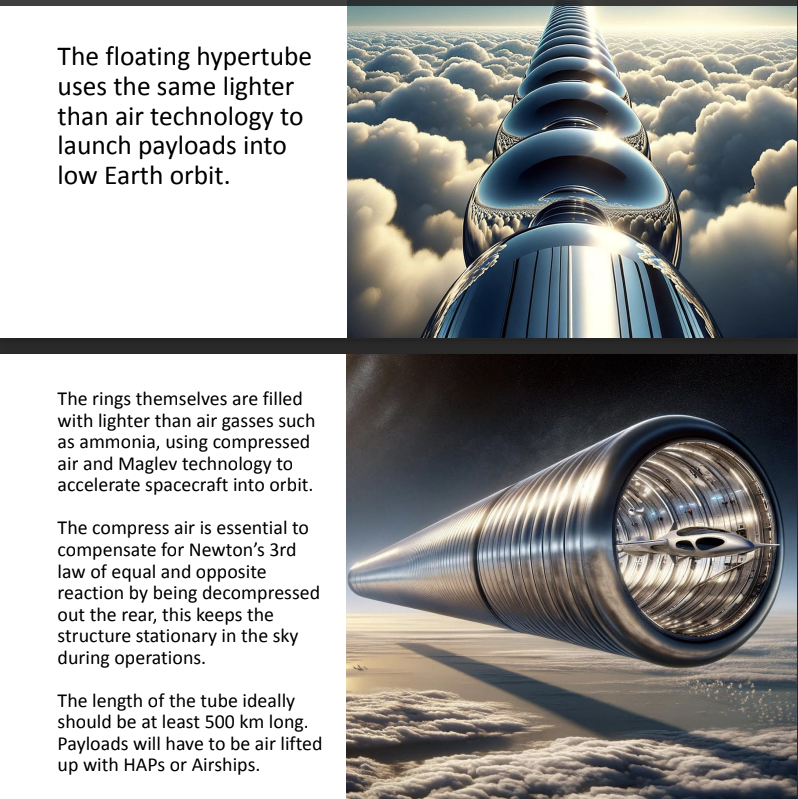
What I realize now is that this actually works better on Venus with a scale height of 16km.
Scale Heights:
1. Earth: 8km
2. Mars: 11km
3. Venus 16km
The larger the scale height the slower the drop in air density and pressure and the farther out into space it reaches. Now Mars has an atmosphere that reaches farther into space but it's density and preassure overall is lesser than Earth. So it's easy to get confused about Mars and why so many think balloons wont work there. They do, but need some adjustment.
Last edited by PhotonBytes (2024-05-26 02:03:55)
I play the piano
https://fb.watch/s7XPqxw02-/
Offline
Like button can go here
#33 2025-04-29 19:40:23
- tahanson43206
- Moderator
- Registered: 2018-04-27
- Posts: 23,338
Re: Mega Igloo ice cavity in Korolev Crater
This topic has a title that includes "Korolev" but it seems to be about something else.
Void has opened a new topic that hopefully will stay focused upon Korolev Crater.
(th)
Offline
Like button can go here

